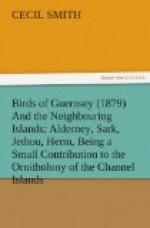170. GREAT BLACK-BACKED GULL. Larus marinus, Linnaeus. French, “Goeland a manteau noir.”—The Great Black-backed Gull is by no means so numerous in the Channel Islands as the Herring Gull and the Lesser Black-back, and is here as elsewhere a rather solitary and roaming bird. A few, however, remain about the Channel Islands, and breed in places which suit them, such as Ortack, which I have before mentioned, as the breeding-place of the Razorbill and Guillemot; and we found one nest on one of the rocks to the north of Herm, but it had been robbed, as had all the other Gulls’ nests about there; we saw, however, the old birds about, and Mr. Howard Saunders found one nest on the little Island of Le Tas, close to Sark; it was quite on the top of the Island, and there were young in it. I have one splendid adult bird, shot near the harbour in Guernsey, in March: I should think this is rather an old bird, as, although there are slight indications of winter plumage on the head, the white tips of the primaries are very large, that of the first extending fully two inches and a half, which is considerably more than that of a fully adult bird I have from Lundy Island. The Great Black-backed Gull is sufficiently common and well known to have a local name in Guernsey-French (Hublot or Ublat), for which see ’Metivier’s Dictionary.’
Professor Ansted includes the Great Black-backed Gull in his list, and marks it as only occurring in Guernsey and Sark. There are three specimens in the Museum—an adult bird, a young one, and a young one in down, with the feathers just beginning to show. In the young bird the head and neck were mottled and much like those of a young Herring Gull in the same state; the back, thighs, and under parts do not appear so much spotted as in the young Herring Gull; the feathers on the scapulars and wing-coverts were just beginning to show two shades of brown, as in the more mature state; the same may be said of the primary quills, which were also just beginning to make their appearance; the tail, which was only just beginning to show, was nearly black, margined with white.
171. BROWN-HEADED GULL. Larus ridibundus, Linnaeus. French, “Mouette rieuse."[36] This pretty little Gull is a common autumn and winter visitant to all the Islands, remaining on to the spring, but never breeding in any of them, though a few young and non-breeding birds may be seen about at all times of the summer, especially about the harbour. Being a marsh-breeding Gull, and selecting low marshy islands situated for the most part in inland fresh-water lakes and large pieces of water, it is not to be wondered at that it does not breed in the Channel Islands, where there are no places either suited to its requirements or where it could find a sufficient supply of its customary food during the breeding-season. Very soon after they have left their breeding-stations, however, both old and young birds may be seen about the harbours and bays of Guernsey and the other islands




